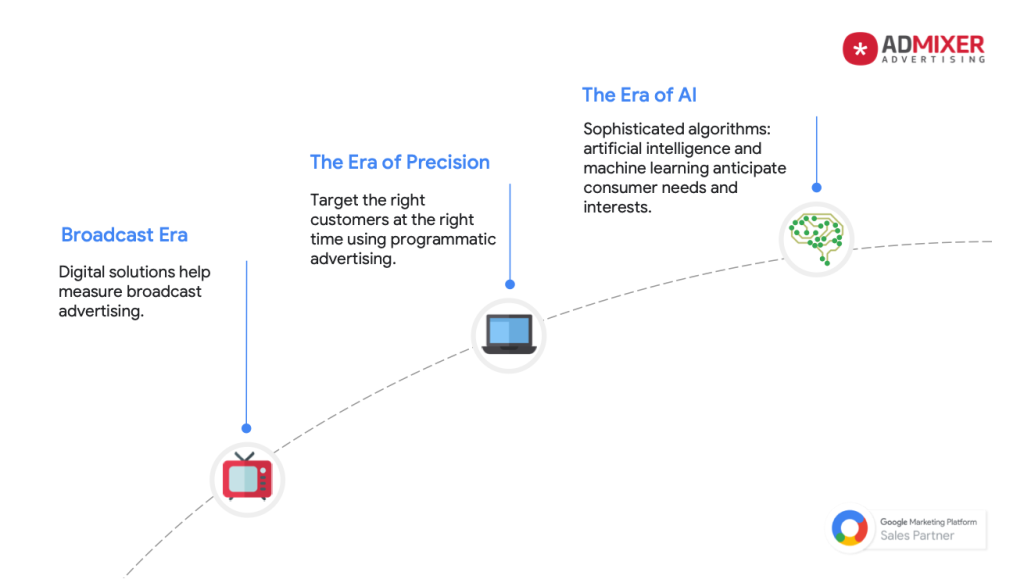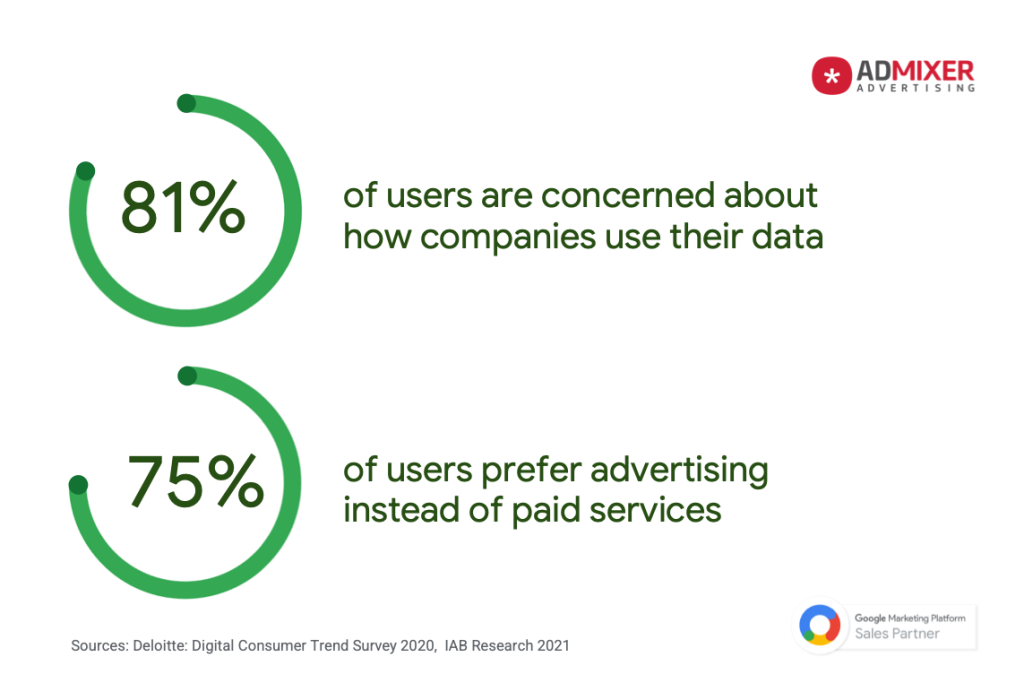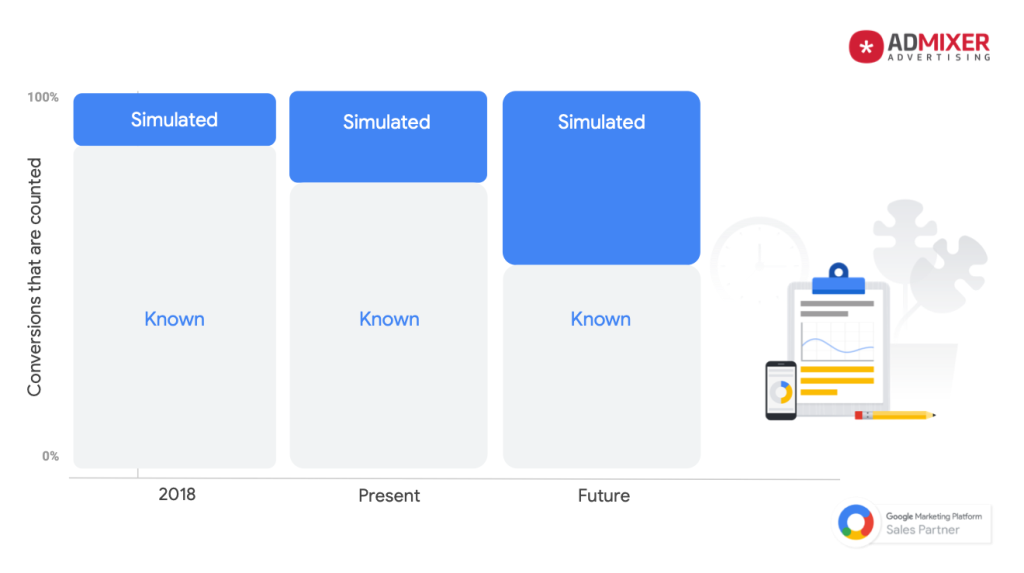Today, we find ourselves at the precipice of a digital advertising evolution. Old technologies reliant on third-party cookies are yielding ground to new, innovative technologies based on artificial intelligence and machine learning.

In the ever-evolving landscape of digital advertising, recent data security regulations such as the General Data Protection Regulation (GDPR) in the European Union and the California Consumer Privacy Act (CCPA) in the US have emerged as pivotal milestones. While empowering users with greater control over their data, these regulations also impose stricter standards on companies regarding data processing and storage.
For advertisers and platforms like Google, this shifting paradigm necessitates not only a reevaluation of data collection and utilization practices but also presents an opportunity to leverage artificial intelligence in advertising endeavors.
In this article, we talk about how to keep your marketing strategies resilient, and future-proof, and learn how to use AI to create more personalized and relevant ad campaigns while respecting data privacy policies.
Alexander Tismenetsky, Managing Director of Google Admixer Advertising, shares insights into three key shifts in privacy dynamics and provides actionable guidelines for advertisers to navigate these changes effectively.
Three drivers of privacy changes: Privacy, Economy, and AI
So, the first driver is the increased attention of users to the issue of data confidentiality. According to a Deloitte study, 81% of surveyed users are concerned about how advertisers use their data1. In response, many developed countries have introduced laws that restrict the use of user data without their explicit consent. Initiatives such as the European Union’s GDPR, California’s CCPA, and Brazil’s LGPD have responded to these user concerns. Thus, about 75% of the world’s population is now protected by new data privacy laws2.

In addition, by the end of this year, Google plans to finally ban third-party cookies (so-called 3rd Party Cookies), which will also help protect user privacy but will certainly affect the effectiveness of advertising campaigns. However, it is encouraging that according to surveys, 75% of users prefer advertising instead of paid services3.
The second driver of change is ongoing economic uncertainty. Thus, 75% of surveyed marketing directors said that they have to achieve great results with limited budgets, striving for profit growth4. And 33% of CFOs believe that advertising spending will either decrease or remain the same this year5. Thus, marketing expectations are increasing to increase profits in the face of shrinking advertising budgets and constraints associated with regulatory restrictions and the disappearance of third-party cookies. The question arises – how to continue to deliver relevant advertising to the target audience when the number of signals from analytical systems decreases?
This is where the third driver of change comes into play: artificial intelligence. Google has been investing in AI for over 10 years. Today, more than 80% of Google advertisers use at least one tool with built-in artificial intelligence6. According to forecasts, in the near future, more than 80% of all digital marketing will work with the participation of AI7. However, for AI to work effectively, it needs “fuel”, namely, data obtained with the consent of users (consented data). The more accurate and complete this data is, the better the AI can perform. Therefore, the key challenge for advertisers is to build a strong foundation for their marketing strategy using high-quality, consistent data that will help drive Google’s artificial intelligence and maximize the ROI of their ad campaigns. Those advertisers who have followed this path have seen an increase in at least 2 key indicators of their KPIs by more than 50%.
AI and conversions: past, present, and future
Artificial intelligence is not a new product that has only recently begun to develop actively. Year after year, Google developers introduce new innovative solutions and AI capabilities are rapidly gaining momentum.
In 2018, of all conversions on a website (for example, in e-commerce), 90% of cases were occupied by known and easily tracked conversions. Most user actions were tracked and analyzed. And only 10% of conversions were modeled using artificial intelligence algorithms.
Today we are already seeing significant progress: in 20% of cases, conversions are modeled by AI and machine learning algorithms. It is predicted that in the near future, about 50% of all conversions will be the result of such algorithms. This means that we will no longer have precise identification of users, but will be able to analyze indirect signs and signals, such as hashed data. This suggests that AI modeling will become a key factor in determining conversions in the future, driven by increased data volumes and improved machine learning technologies.

Artificial intelligence is not intended to replace specialists, but to complement their work. It will play a key role in tasks such as choosing a platform for advertising, determining bids, and other areas where analysis and processing of large amounts of data are required.
The power of data combined with Google tools
As noted earlier, even the most advanced artificial intelligence algorithms need data for training and initial calculations to model the user journey effectively. However, the data that advertisers and marketers receive from third-party providers is becoming outdated and cannot be updated in the required format. Therefore, marketers are left to rely on their data.
To do this, the site must have a form that allows you to collect primary (1st party) user data. For example, a brand might offer a 10% discount or other incentive in exchange for an email address and data.
Once they receive the email, marketers can use it for the following purposes:
- Offer to subscribe to the newsletter.
- Tracking activity and preferences on the site.
- Gathering additional information, etc.
The importance of primary (1st party) data for businesses today cannot be underestimated. They are the basis of the entire system of training artificial intelligence algorithms used to analyze user behavior and make more accurate marketing decisions.
| 1Р Date (personal data that the user leaves on the site: email, phone, etc.) | Advertiser / Website / Google Analytics |
| Consent Mode (user consent to the use of his personal data) | Advertiser / Website / Google Analytics |
| Privacy Sandbox (browser identification based on cohort analysis of browsing history, rather than user analysis) | Google / Chrome / Website |
| AI (behavior and conversion modeling tools) | Advertising agency / Technology Platform (GMP) |
This systematic approach, which includes 1st party data collection, Consent Mode, browser identification, and AI capabilities, allows companies to improve personalization, increase the effectiveness of their advertising campaigns, and achieve better results in audience segmentation and predicting consumer behavior.
Conclusion and recommendations
According to forecasts, in the near future, changes in the privacy environment will affect 75% of the planet’s population, which means it will become impossible not to take into account the new privacy rules1. To successfully adapt to changes in data privacy standards and create a solid foundation for your marketing strategy in 2024, the experts at Admixer Advertising recommend the following certain steps:
1. Upgrade to Google Analytics 4 (GA4). If you haven’t taken this step yet, do it as soon as possible. This will allow you to use more advanced and powerful analytics tools to track and analyze your data.
2. Set up and activate Consent Mode (consent banner) for audiences from European Union (EU) countries according to instructions from Google. This will allow you to transfer data with the consent of EU countries users to your GA4 property without loss. You can use paid Consent Management Platforms (CMP) recommended by Google or do the setup yourself.
3. Update Google SDK for Mobile App and Google API. If you work with mobile apps or exchange data between different advertising platforms via the Google API, make sure your tools and APIs are updated to the latest version available.
You can get additional advice on these issues and other aspects of Privacy and Data strategy for your business from Admixer Advertising specialists by sending a request to hello-gmp@admixeradvertising.com.
Our company has been an official reseller of Google Marketing Platform in the EMEA region since 2016 and a certified Google partner. We are ready to help you access and improve the use of advanced advertising technology, analytics, creative, and cloud platforms in your business.
Sources:
- Deloitte: Digital Consumer Trend Survey 2020
- Gartner: The TOP 8 predictions for 2021-2022
- IAB Research 2021
- Gartner Research May 2023
- Ipsos pull via eMarketer, June 2023
- GroupM & MMA India Mobile Marketing Ecosystem Report 2020
- GroupM AI Powered = Fully automated across inventory and fully automated inventory specific













